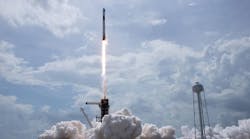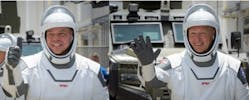These days everything is drowned out by either COVID-19 or protests. This isn’t to say that either is unimportant, but significant issues are often get overshadowed during such times. One was the launch of SpaceX’s Dragon capsule that was shot up to the International Space Station (ISS) using a Falcon 9 launch vehicle. It’s the first manned launch in years from the U.S.—the astronauts in the capsule were Robert Behnke and Douglas Hurley (Fig. 1).
1. Robert Behnke (left) and Douglas Hurley (right) are shown wearing SpaceX spacesuits.
I watched the NASA stream and others on Saturday, May 30, along with probably most of you. The rocket took off from NASA’s Launch Complex 39A at the Kennedy Space Center in Florida. This mission was known as Demo-2, but if you watched the NASA video stream, it was more like the Bob and Doug Show. I’m not sure if they mentioned their last names more than a couple times. I guess they could have talked about Elon (Musk) and other involved in this historic launch, but I digress.
It was an impressive show in part because of the advanced communication and imaging systems that let you watch everything in real time, including shots from inside the capsule as well as from the launch vehicle. Everyone was able to watch the main engine cut off (MECO) at T+00:02:40 (Fig. 2).
2. NASA and SpaceX launch astronauts to space! The actual launch is about 4:22 into the video and the main engine cut-off (MECO) is at T+00:02:40, or about 7:02 in the video.
What I found more interesting was the split screen showing the second stage as well as the main stage returning to earth. The actual landing view was shot from a craft that was close to the robot landing platform (Fig. 3). The rocket could land on any platform, but the easiest location to land when launching from the Kennedy Space Center is in the Atlantic Ocean. The unmanned robotic ship allows the platform to be small while keeping everyone safe in the event of a crash.
3. Space X Falcon 9 Engine landing on the ship.
There are some spectacular failure videos on YouTube as well. It just goes to show that rocket science is hard, and things don’t always go smoothly.
If you watch the videos until they enter the ISS, then you’re in for a wait. The approach to the space station is like watching paint dry, but we were enthralled. NASA did a few video tricks to highlight the jets used to position the capsule as it approaches the ISS. Some of the tasks were performed manually while others were done automatically. This was a test after all.
The Falcon 9 has already seen a lot of testing and is essentially a commercial workhorse. The ability to reuse the first stage reduces the overall cost and allows more launches to occur since building one from scratch takes time. It’s not quite a relocation and refill proposition, but close to it. The rocket is spec’d for 10 uses.
The Dragon capsule was also in the mix. It had flown before, unmanned, to the ISS. However, this was the first time it had astronauts inside (Fig. 4). The current capsule will probably not be reused—it will be examined in detail upon its return. In theory, though, the capsule will also be reused.
4. Video inside the SpaceX's Dragon Endeavour spacecraft.
The astronauts were wearing new, stylish space suits. These provide more flexibility and are still built to fit. They weigh about 20 lbs. and are made of fire-retardant Kevlar and Nomex. A single cable provides air, power, and communications. The 3D-printed helmet includes integrated valves and microphones. The gloves are designed to work with the three large touchscreens in the capsule.
The touchscreens are among the obvious differences between the Dragon and prior capsules that had loads of switches and small displays or indicators. The astronauts could be seen scrolling through lists with a flick of their finger.
Space travel may eventually become commonplace and even as economical as air travel, but that’s still a ways off. In the meantime, there will be more launches and more trips to ISS as well as other projects.
Bob and Doug may have been the stars of the show, but it took a lot of people, including engineers and developers, to make this a success. I tip my hat to NASA, SpaceX, and all of the engineers, developers, and others involved in this and other projects that are changing the way we enter outer space.

